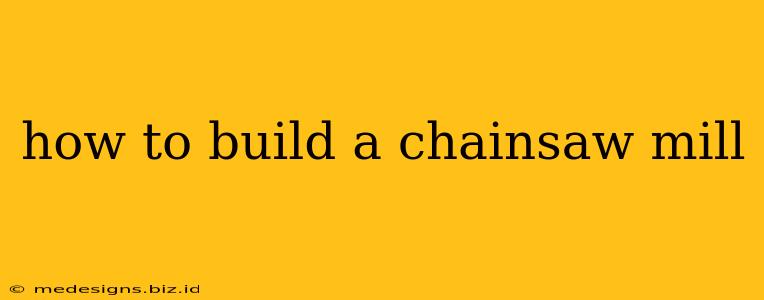Building your own chainsaw mill can be a rewarding project, offering a cost-effective way to process logs into lumber. This guide will walk you through the process, covering everything from planning and design to safety considerations and operation. Whether you're a seasoned woodworker or a weekend DIY enthusiast, this comprehensive guide will equip you with the knowledge to build a functional and safe chainsaw mill.
Planning Your Chainsaw Mill
Before you begin constructing your chainsaw mill, careful planning is essential. This stage determines the success and safety of your project.
Choosing the Right Design:
Several chainsaw mill designs exist, each with pros and cons. Popular choices include:
- Horizontal band saw mill: Offers precise cuts and is generally safer, but requires more construction expertise.
- Vertical Alaskan mill: Simple to build and operate, ideal for smaller logs and less demanding projects.
- Swing blade mill: Versatile but requires more skill to operate safely due to the swinging motion.
Consider your budget, experience level, and the type of lumber you plan to process when selecting a design. Research various designs online to find one that aligns with your needs and capabilities.
Gathering Necessary Materials:
The materials required will vary depending on your chosen design. However, common materials include:
- Strong steel: For the frame and other structural components. Ensure the steel is of sufficient thickness to withstand the stress of milling.
- Heavy-duty lumber: To build the base and supporting structures. Choose a durable wood species resistant to rot and warping.
- Appropriate fasteners: Bolts, nuts, and washers are crucial for a secure and stable mill.
- Chainsaw: A powerful chainsaw with a good-quality bar and chain is paramount. Consider the bar length in relation to the log sizes you'll be processing.
Create a detailed materials list to avoid costly delays and ensure you have everything you need before you start.
Safety First:
Safety is paramount when working with power tools. Before you begin construction, consider the following safety precautions:
- Personal Protective Equipment (PPE): Always wear safety glasses, hearing protection, gloves, and sturdy work boots.
- Proper Work Area: Choose a well-lit and level work area, free from obstructions.
- Secure Workholding: Ensure the logs are securely clamped to prevent kickback or movement during milling.
- Emergency Plan: Have a plan in place in case of an accident and keep a first-aid kit nearby.
Constructing Your Chainsaw Mill
The specific construction steps depend heavily on your chosen design. Detailed plans and diagrams are readily available online for different chainsaw mill designs. Always follow the chosen design's instructions carefully.
Here's a general outline of the construction process:
- Build the Frame: Construct a sturdy and level frame to support the milling mechanism. This is the foundation of your mill, ensuring stability and accuracy.
- Install the Guide System: This system guides the chainsaw and prevents it from straying from the cutting line. Accuracy is vital for producing quality lumber.
- Attach the Chainsaw: Securely mount the chainsaw to the frame. Ensure that the chainsaw is firmly attached and operates smoothly.
- Test and Adjust: Before using your mill with actual logs, perform thorough testing and adjustments to ensure everything operates correctly and safely.
Operating Your Chainsaw Mill
Once your chainsaw mill is complete, operating it safely and efficiently is crucial.
Essential Operating Tips:
- Practice makes perfect: Start with smaller logs and practice your technique before tackling larger, more challenging pieces.
- Proper log placement: Ensure the log is firmly secured and properly aligned.
- Smooth and controlled cuts: Avoid jerky movements and maintain a consistent speed to prevent binding and kickback.
- Regular maintenance: Keep your chainsaw well-maintained and sharp for optimal performance and safety.
Conclusion: Enjoy Your New Chainsaw Mill!
Building your own chainsaw mill is a project that demands careful planning, meticulous construction, and a commitment to safety. By following these steps and prioritizing safety, you can create a valuable tool for processing your own lumber, opening up a world of possibilities for woodworking projects. Remember, consistent practice and adherence to safety procedures are vital for successful and safe operation.
